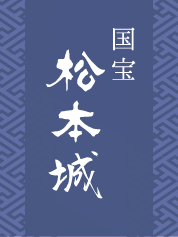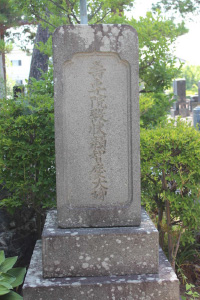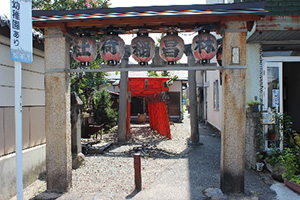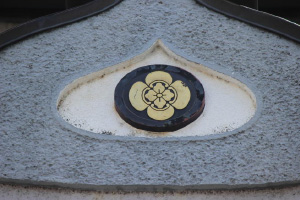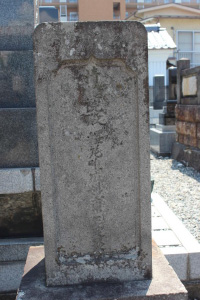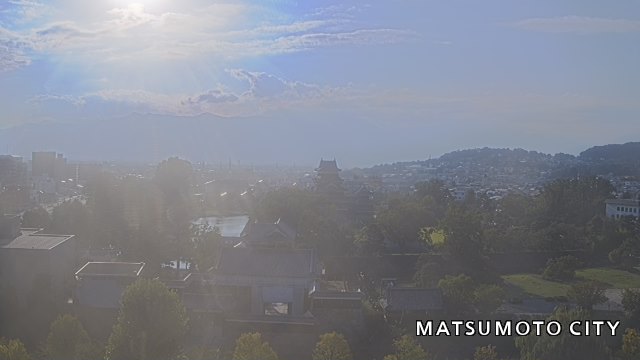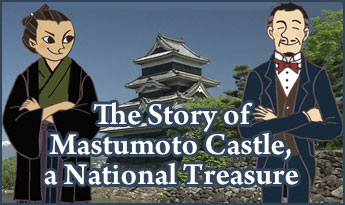East trail
Starting from the Taiko Gate, you can enjoy the town of town people.
You can enjoy the only temple with 10 kings in Juo hall in Esashi-machi among the four halls which was located at each entrance of the compass to the Matsumoto castle environs. You can also enjoy the prefectural treasure,
Route map
There are many segments to the east trail

Taikomon (Taiko Gate)
Magnificent and very well constructed gate leading to the main enclosure of a castle and outer citadel.
Taikomon was a very important gate to the main enclosure of a castle and outer citadel. It is magnificent and very well constructed.
There was a turret next to the Taikomon (Taiko gate) and the drum and bell were positioned. This drum and bell were used to inform the local inhabitants the time and when the samurai was on the way to the castle. Therefore this gate is called Taikomon (Taiko Gate)
However when the samurai period ended, this gate was slammed in 1871.
Because the gate was very significant to the local people they had desired to have it reconstructed. And this wish was fulfilled in 1998.
On the east side of the gate, there is the biggest stone in Matsumoto castle. This stone is called "Genba Ishi" (Genba Stone) after the office of Yasunaga Ishikawa who constructed the castle tower.- Continue to walk about 7 minutes

Fukuromachi (bag town)
The streets in the samurai town are uniquely laid out and this is referred to by the local Japanese as being "lost in the bottom of a bag."
In the north part of the castle environs there was a town where normal town people lived along Zenkoji Street next to the Samurai quarter.
Exit from the east gate and walk along the dense on the left hand side, there is a town called "kataha" (side edge) named after the structure of the town which has houses only on one side. Walk up to the north, at the boarder of Kataha and Shinmachi, there is a road to the east called "Kamiumadashi " which leads north to "Fukuromachi" which is a town of samurai.
When you look at the north direction from the south, it looks like the road ends at the end of the north. However when you go to the end of North side of the road, the road leads to the right and then left and continues. This structure of roads is called "kaginote ". This town is called Fukuromachi because the road looks like a bag which has a sealed bottom. The streets are narrow and windy to prevent attacking forces. The layout makes enemies disorientated which gives advantages to the local defending forces.- Continue to walk about 5 minutes

Kamisuki-gawa (Kamisuki River)
It was named after the house where paper was made. "kami" means "paper" and "suki" means making paper from wet material by spreading and drying it.
Kamisuki-gawa (Kamisuki River) is one of the rivers which runs from North to South in the castle environs. The river runs between two towns, Higashi-machi and Ueshita Yokota-machi.It seems to have been a small river which was made run systematically for domestic use when Higashi-machi and Ueshitayokota-machi was established.
The river runs to the south behind houses and to the Metobagawa (Metoba River). Very small amount of water runs this river but you can see how this river was used long time ago, for example, the assembles of the stones on top of each other.
The process of making paper from bark using a large amount of water is called "kamisuki". A large amount of water was used to make papers. It was named after the house where paper was made. "kami" means "paper" and "suki" means making paper from wet material by spreading and drying it.
In the East, a tower of temple can be seen. There is Anrakuji (Anraku Temple), now known as Daianrakuji (Daianraku Temple) and the Buddhist deity of mercy was worshipped. This road leads to the Buddhist deity of mercy, therefore the road is called "Kannon Kouji" - "Kannon" means the Buddhist deity of mercy and "Kouji" means road.- Continue to walk about 1 minute

Kami-Yokota-machi and Shimo-Yokota-machi
The town of townspeople where many temples are assembled to protect the castle environs.
Towards the east of the castle environs there is a town called Higashi-machi which runs from North to South and this is also a part of Zenkoji Kaido (Zenkoji Street). In the east of Higashi-machi there were wards called Kami-Yokota-machi and Shimo-Yokota-machi in the east of the town. Higashi-machi and Kami-Shimo-Yokota-machi were connected by several roads called "kouji ". Both Higashi-machi and Kami-Shimo-Yokota-machi are renowned for being people towns.
The East of Yokota-machi is outside the castle environs. There were temples here. These temples were built at the same time when the castle environs was established specifically protect the castle environs. Some castle environs in Japan are called "Tera-machi" (Temple town). This castle environs in Matsumoto is not called "Tera-machi" (Temple town) but it has similar aspects as other castle environs.
Chosyoji Judoshinshu-Ohtani-Ha, Honganji-Matusji, Kisosan-Gichuin-Chosyoji. The principal object of worship is Amidanyorai. Kamiyokotamachi.
In the Kanei year 2 (1625), Tanbanokami Yasunaga Matusdaira moved the temple to Izumicho and worshipped. In the Meireki year 2 (1656), Dewanokami Tadamoto Mizuno (the second generation of the Mizuno castle master) built a temple and was completed in Manji year 3 (1660).
There is a grave of the birth mother of Mitsumasa Toda (later the forth generation of the Toda castle master). On the grave, the following words are engraved. 「壽專院殿快顔智慶大姉」「天明八年(1788)庚申十月二十六日」. It reads Toda-mitsuo-junshitsu-mitsumasa-seibo-hisada.
Rinshyoji Judo sect, Chionin-matsuji, Inarisan-rinryoji. The principal object of worship is Amida-nyorai. Kami-yokotamachi.
Tanbanokami Yasunaga Matsudaira worshipped this temple and renamed to Inarisan-seidenin-rinsyoji. According to one theory, Jiuemon Inukai, posthumous Buddhist name Hogo, renamed Rinsyoji. There is a tsuzumigataki in the temple garden which is known to be an architecture of the domain master Mizuno.
There is a Rinsyo God Inari Shirine in the shrine ground of Syorinji.
Ekouin Rinzaishu-myoshinji-matsuji. Enkaku-sane-kouin. The principal object of worship is Shaka-nyorai, Fudou-myouou. Kami-yokotamachi.
The temple called Renmyouji in Shimizu in August, the Kanei year 17 (1640) was renamed by the master of castle, Kaganokami Masamori Hotta. The name Ekouin was from the posthumous Buddhist name of his brother Sahee, Ekouin-denkuukakusouen-koji,
Syogyoji Jodoshinsyu-higashihonganji-matsuji. Daihouzan-sensyuin-syogyoji. The principal object of worship is Amidanyorai. Shimo-yokotamachi.
Founded by Ryochisyonin. It was originally located in Kitakuribayashi ward in Shimadachi and was relocated to Rokku (Northwest of Chitose Bridge along the Metoba River) in the Bunroku year 1 (1592). It was used as a Bodaisyo by Houkinokami Yasumasa Kazumasa Ishikawa. It again was relocated to this location during the period of Keicho (1596-1614) because of an expansion of the castle moat.
Behind the main building of a temple, there is a grave of the birth mother of Mitsumasa Toda (later the fifth generation of the Toda castle master). It is engraved 「淸澄院殿釋尼唯戒妙甫正定聚」「享和二年(1802)壬戌六月二十六日」 meaning Toda-mitsuo-junshitsu-mitsuyoshi-seibo-taniguchi.
- Continue to walk about 10 minutes

Juoudo (Juou Temple)in Esashi-machi
Heaven or Hell, the king of Hell, the jury
At each entrance of the compass to the Matsumoto castle environs, Juou was placed. Juou are worshipped in the king of hell temple at right hand side of "houkouan", where a guardian deity of children is placed, at the east entrance/exit leading to Esashi-machi. There are four Juoudo (Juou Temple) at the entrance/exit of the castle environs but this is the only temple with Juou present. Among those statues, the king of Hell is very large and magnificent. Juou are worshipped in the king of hell temple at right hand side of "houkouan", where a guardian deity of children is placed, at the east entrance/exit leading to Esashi-machi. There are four Juoudo (Juou Temple) at the entrance/exit of the castle environs but this is the only temple with Juou present. Among those statues, the king of Hell is very large and magnificent.
It was believed that Juou judged people if they did something good or bad while they were alive. The king of Hell is the centre of Juou as we say the jury. Dead people are asked questions in front of the king of Hell. And the judgement of if they can go to the heaven or hell was made from the statement. Therefore he was feared and respected.
A long time ago, children were told by adults "If you lie, the king of Hell will come to get your tongue". Children made a promise not to lie because they were afraid of being cursed.- Continue to walk about 2 minutes

A bell tower of Nenraiji (Nenrai Temple)
A bell tower built during the middle period of the Edo era which is now a Nagano prefectural treasure.
This building used to be a temple called Nenrai Temple but it lost its function as a temple at the beginning of the Meiji era. There was a large bell many years ago to let people a time and when disaster happened.
This building was built during the Mr. Mizuno period and there is a record that it was built by carpenters from Osaka in 1705. The height of the building is 13 metres. When you look up, you can see the engraved clouds on a board at edge of the eaves as well as the compass where the bell was hanged. The bell was transferred and the building lost its bell during the Pacific War. This building became a Nagano prefectural treasure in 2012 for its spectacular architecture.
The bell tower is protected with grave yards by Myoushouji (Myoushou Temple) which built new buildings such as a main temple next to the bell tower.- Continue to walk about 4 minutes

Iori-Reisui
The well which is located near a grave of Iori Suzuki who stood by farmers.
There are two large monuments beside the well. The monument in the left is a grave of Iori Suzuki.
There is a record that visits from farmers were declined by a domain when Iori deceased.
Because the well is located near Iori's grave the well is called "Iori's miraculous water".
In the east of the well there is a graveyard. During the Edo era there was a temple called Honryu Temple. Because the entrance to this temple was in the west. There were many temples around this area.- Continue to walk about 4 minutes

>A former Agetsuchi jail
This is where a jail of Matsumoto domain was. There was a period when nobody was jailed.
This is where a jail of Matsumoto domain was. There were a few sections for each status. Not much details are recorded about Matsumoto, but a typical jail in this period was divided into two sections. One section was called Ageya which had tatami mat and this was for samurai, priests, powerful town people and farmers. Another section was a shared large room.
It shows on the record of the Mr. Toda period that there was nobody in the jail when Mitsuyoshi ruled compared to other times when there were always 4 to 5 people in the jail. It also says that Mitsuyoshi was known to be a good lord in managing towns and people.
In the north of the road, there was a moat. If you look carefully, you can see the grounds lower than other area. The town was built of the soil from digging a moat, therefore this town is called "Agetsuchi (a mount)".- Continue to walk about 1 minute

East gate and the guard
The largest guard among four in Matsumoto castle.
It was the exit from the most area of the castle and there were the east gate and the guard.
The gate is 5.4 meter and 12.1 meter in size. There is an area in the west of the gate and there was a guard room and a well. Earth bridge was 32 meters long.
It was the largest one among the four in Matsumoto castle. In the front, there was a pile of soil so inside could not see.
The entrance/exit are located in South and North. There was a wood bridge over the north moat and there was an earth bridge over the south moat. It leads to the road in Higashimachi by turning right after crossing the bridge in the north. This road was called Shimoumadashi.
